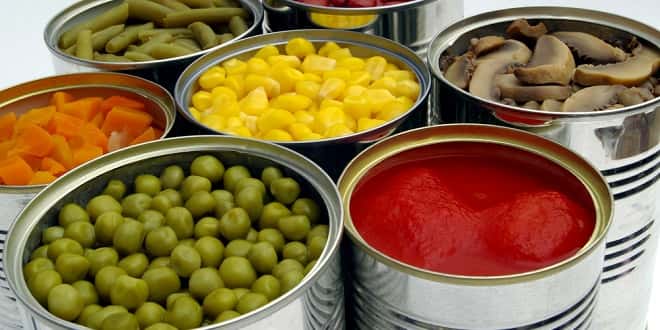Aseptic Processing vs. Conventional Canning
Problem:
1. Canning overcooks foods, giving poor quality
2. Cans are inconvenient and unsafe
Solution:
Aseptic Processing
Aseptic Bag vs. Can
“Aseptic Processing and Packaging means the filling of a commercially sterilized cool product into presterilized containers, followed by aseptic hermetical sealing, with a presterilized closure, in an atmosphere free of microorganisms.”
“Commercial Sterility of equipment… means…free of viable microorganisms having public health significance, as well as microorganisms of nonhealth significance, capable of reproducing in the food under normal nonrefrigerated conditions of storage and distribution.”
“Low-acid foods means any foods, other than alcoholic beverages, with….
pH greater than 4.6 and a Water activity (aw) greater than 0.85….
Tomato products having…pH less than 4.7 are not classed as low-acid…”
Heat Exchangers
Aseptic
Packaging
Brick Packs
Batch Retort
The problems with cans and jars (aseptic alternative):
1. Overcooking because of slow heat transfer to and from the center of the container (HTST processing).
2. Overcooking means poor food quality (HTST reduces overcooking).
3. Containers are limited in size to #10 or smaller (single serving to tanker ships).
The problems with cans and jars:
4. Cans are difficult to open. (plastic and paper more easily opened)
5. Opened can lids are sharp and cause cuts, insurance claims. (plastic and paper safer)
6. Partially used cans difficult to reseal, bulky to store. (zip locks reseal, bags collapse)
7. Cans make bulky rubbish (plastic and paper collapse more easily)
The problems with cans and jars:
8. Blanch for shrinkage, before canning. (blanching and cooking are one step)
9. Cans/jars must be filled with liquid for heat transfer. (liquid can be drained before packaging)
10. Energy and water intensive. (reduced energy and water consumption)
The problems with aseptic processing:
1. Technology intensive, mechanically complex system.
2. Not yet practical for low-acid foods with particles.
3. Paper and plastic more permeable than metals cans and jars—oxygen is a problem.
4. Capital already invested in canning.
Container/Surface Sterilants
Hydrogen Peroxide (H202) –FDA approved in 1981, considered a breakthrough.
Heat (steam or hot air)—not compatible with plastics, good for metal drums.
Iodine—NFCOJ silos.
Irradiation —popular for bag-in-box.
Other—UV, Acetic Acid, Ozone, etc.
Sterilizing Bulk Storage Tanks
1.Potable water rinse
2.Wash w/ caustic solution
3.Phosphoric acid rinse
4.Fill w/ iodine solution
5.Drain with filter-sterilized Nitrogen
6.Sterilize piping with hot water
Juice tanks
Stainless steel
100,000 gal
NFCO Orange juice
Bulk Storage Tanks
Store NFCOJ one year @ 35 F.
Keep sterile for 4 years.
Stainless steel for smaller tanks.
Epoxy lined carbon steel for larger tanks.
Typical size: 1,000,000 gallons.
Over 100 such tanks in use.
Tanker ship: 3.2 million gallons.
Hold Tube
1.Measure temperature at both ends.
2.No heating allowed.
3.Not insulated (Hold tubes may be insulated to
protect the hold tube from external extreme temperatures.
This is acceptable as long as no external heat source is
applied to the hold tube ).
4. Away from drafts and drips.
5. Slope upwards 0.25 inch per foot to avoid
air pockets and ensure self draining.
Hold Tube
6.Only hold tube time counts toward lethality (not heat exchanger times).
7.Fastest increment (shortest residence time) must be sterilized.
8.Solid particle residence time and temperature unpredictable, so no FDA approved system is in commercial use to aseptically process low-acid foods with particles.
Process Development
PDA Mushroom Processing Project
(Walker and Beelman)
1.Configure our system for mushrooms.
2.Determine operating conditions for optimal mushroom quality.
3.Compare yield and quality of segmented-flow processing with canned mushrooms.
4.Demonstrate technology to Pennsylvania food processing industry.
5.Final Report
Aseptic vs. Canning
Whole Mushrooms (Nate Anderson)
6.1% Higher yield
3.1% Greater whiteness (L-value ratio)
6.0% Less color change (ΔE ratio)
3.9% Better texture (Shear work ratio)
Apple Slices (Manolya Oner)
14.6% Higher yield
1.82% Greater whiteness (L-value ratio)
2.01% Less color change (ΔE ratio)
45.1% Better texture (Shear work ratio)
Aseptic Processing…….
…hope it’s been “enlightning”!
…

